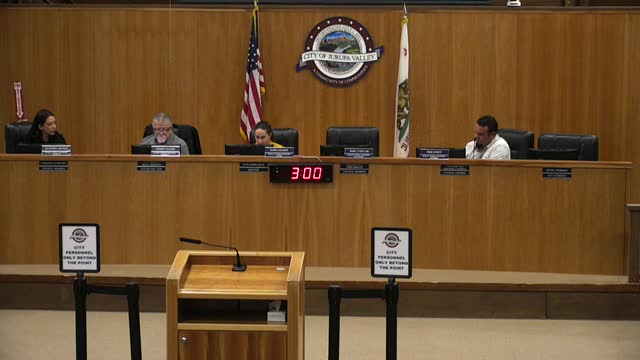Jurupa Valley outlines NPDES compliance plan, full‑capture installations to meet state trash amendment
January 09, 2025 | Jurupa Valley, Riverside County, California
This article was created by AI summarizing key points discussed. AI makes mistakes, so for full details and context, please refer to the video of the full meeting. Please report any errors so we can fix them. Report an error »

City environmental staff briefed the Public Works Advisory Committee on Jan. 9 about the city’s responsibilities under the NPDES stormwater permit and California’s statewide Trash Amendment, including the planned installation and maintenance of full-capture trash devices.
Debbie, identified in the meeting as the city’s environmental manager, explained that the NPDES program stems from Section 402 of the Federal Clean Water Act and that the city operates under general permit coverage with Riverside County Flood Control as the principal permittee. Jurupa Valley is a Phase I jurisdiction, and the updated permit (scheduled for adoption later in the year, per the presentation) carries stricter monitoring and reporting requirements, a more extensive watershed management plan, and tighter construction controls.
Regarding the Trash Amendment, staff said the state adopted measures to eliminate trash discharges into California waterways by 2030 and established priority land uses for compliance. Jurupa Valley elected “Track 1” compliance, which requires the city to install and operate full-capture trash-capture systems at outfall locations. Debbie said the city’s standard device is a StormTech full-capture system.
Debbie reported that the city has a requirement to install 506 full-capture devices under Track 1. She told the committee that 215 devices are currently installed and that 221 devices remained outstanding per her slide; she said 70 devices are slated for installation within the next three months, bringing the city to 285 installations by May 2025 and helping meet the 50% installation target for 2025. Staff said the program will continue toward full compliance by 2030.
Staff described the devices as designed to fit existing infrastructure and said they are retractable to allow removal and cleaning. The presentation noted maintenance tracking requirements: staff must record debris tonnages and maintenance frequency, capture inspection and maintenance photos in the city’s GIS, and retain records to support compliance during audits. The city also plans to require that large development projects install full-capture devices so developers bear installation costs where appropriate.
Committee members asked about inspection frequency and who must be inspected. Debbie said inspections of industrial, commercial and food facilities are risk‑based (annual, multi‑year schedules) and that catch basins and full-capture devices are inspected and tracked to establish maintenance frequency; catch basins are inspected annually and staff will analyze debris tonnages to set servicing intervals. Staff said 70 devices will be installed in the next three months and an additional 5 catch basins will be cleaned as part of that work, and that the city will continue using contractors and in-house crews for installation and maintenance.
Ending: Staff said the city is on a path to meet the 50% installation requirement by 2025 and the full 100% installation by 2030, will keep GIS-maintained records for audit purposes, and will return with implementation updates as installations progress.
Debbie, identified in the meeting as the city’s environmental manager, explained that the NPDES program stems from Section 402 of the Federal Clean Water Act and that the city operates under general permit coverage with Riverside County Flood Control as the principal permittee. Jurupa Valley is a Phase I jurisdiction, and the updated permit (scheduled for adoption later in the year, per the presentation) carries stricter monitoring and reporting requirements, a more extensive watershed management plan, and tighter construction controls.
Regarding the Trash Amendment, staff said the state adopted measures to eliminate trash discharges into California waterways by 2030 and established priority land uses for compliance. Jurupa Valley elected “Track 1” compliance, which requires the city to install and operate full-capture trash-capture systems at outfall locations. Debbie said the city’s standard device is a StormTech full-capture system.
Debbie reported that the city has a requirement to install 506 full-capture devices under Track 1. She told the committee that 215 devices are currently installed and that 221 devices remained outstanding per her slide; she said 70 devices are slated for installation within the next three months, bringing the city to 285 installations by May 2025 and helping meet the 50% installation target for 2025. Staff said the program will continue toward full compliance by 2030.
Staff described the devices as designed to fit existing infrastructure and said they are retractable to allow removal and cleaning. The presentation noted maintenance tracking requirements: staff must record debris tonnages and maintenance frequency, capture inspection and maintenance photos in the city’s GIS, and retain records to support compliance during audits. The city also plans to require that large development projects install full-capture devices so developers bear installation costs where appropriate.
Committee members asked about inspection frequency and who must be inspected. Debbie said inspections of industrial, commercial and food facilities are risk‑based (annual, multi‑year schedules) and that catch basins and full-capture devices are inspected and tracked to establish maintenance frequency; catch basins are inspected annually and staff will analyze debris tonnages to set servicing intervals. Staff said 70 devices will be installed in the next three months and an additional 5 catch basins will be cleaned as part of that work, and that the city will continue using contractors and in-house crews for installation and maintenance.
Ending: Staff said the city is on a path to meet the 50% installation requirement by 2025 and the full 100% installation by 2030, will keep GIS-maintained records for audit purposes, and will return with implementation updates as installations progress.
View full meeting
This article is based on a recent meeting—watch the full video and explore the complete transcript for deeper insights into the discussion.
View full meeting
